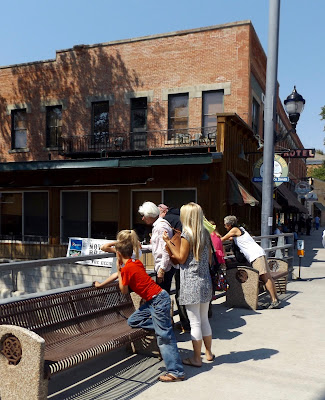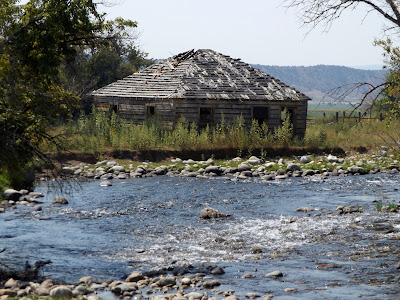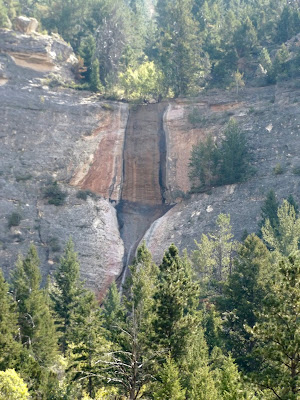August 21, 2017
A half hour later, I am still literally feeling the incredible energy rush from viewing the total solar eclipse! It truly was an awesome experience, completely beyond anything that I ever could have imagined, and to be quite honest, I wasn’t overly excited about it to start with.
It was nothing more than happenstance that our summer sojourn was taking us to approximately the right place at approximately the right time, so why not do the obvious thing and follow suit like about a zillion other people.
Not wanting to completely alter our travel track, we made arrangements to bide a while in Buffalo, Wyoming, and to bop down to Casper for the event. That city just happened to be on the path of totality, eclipse-wise. I just love the sound of that: the path of totality. Sounds just a bit on the doomsday side, actually. And I can’t help but wonder about how primitive man must have felt at seeing such a happening and not knowing what was transpiring; it must have been terrifying.
The folks in Casper knew how to make the most of being smack dab in the track of a major celestial occurrence. There were big doin’s: four days and nights of revelry, festivals, fairs, concerts and eclipse parties. We went downtown to indulge in a bit of revelry ourselves and to get us in the mood.
 |
| Barbershop harmony, Wyoming style |
Our other reason for visiting that town was to decide from where we might view the eclipse. We had heard that mobs and mobs of people were expected wherever the eclipse was to be total, so a plan seemed to be in order.
We found parking lots blocked off to deter eclipsers; others were renting out spaces for astronomical prices. Many were taking reservations and chalking out places for campers or parkers or sitters and they all seemed to be sold out.
Just because we were already there feeling like lost little waifs with no idea what to do, we took some time to enjoy Casper's Historic Trails center. The city's site is on the North Platte River, a crossroads of 19th Century westward-moving pioneers, making it well worth a revisit for the purpose of seeing what is to be seen in regards to those emigrant trekways.
The center's interactive displays were unique and well-done - in a word, fascinating. We "rode" the covered wagon as it forded the Platte. To make the ride as authentic as possible, a wagon with sensors was taken across the river and the experience recreated in the museum. As we sat inside the prairie schooner, we looked out the front onto a film with audio of a wagon train bumping its way over the rocky river bottom, creating a very real sense of what it would have been like. Another similar display was with a stage coach, and we got to try our hand at pulling a hundred-pound handcart of the type and weight used by the Latter Day Saints to cross the plains. I'm here to tell you it was pretty dang difficult, but I place the blame on doing it in sandals, which I'm pretty sure the Mormons didn't do.
As an aside, I will mention that my niece's 3 great grandparents, Jens Peterson and Anna Jensen with their family, including her 2 greats grandfather, Peter O. Peterson, migrated to Salt Lake City in one of those handcart companies, eventually settling in Graham County, Arizona.
So now I have really digressed!
Back to the eclipse: we hadn’t even thought far enough ahead to get viewing glasses. A couple of places we checked were sold out already, but we got two pair from a place that had four left out of the 1,100 he had the previous day.
We would arrive in Casper early on the day of, but would all the lots and roadsides be filled? We had no way of knowing, so the señor calculated the - yup, there it is again - the path of totality. Seems that Poison Spider Road was just about exact dead center, and that was where we found our spot.
A ranch had a sign out front: “Eclipse camping”, so we turned in and had a nice chat with Janiell. We didn’t need to camp; despite her obvious inclination to allow us a parking spot without charge, I offered her $10 and we were guaranteed a place to call our own, for a spell at least, plus a porta-potty in case of need.
Janiell had 30 or so campers around her property and us, and the wait began, which gave us ample time to wander the creek and wetlands. In the process, we picked up a couple of new birds for the trip list: Wilson’s snipe, western meadowlark and warbling vireo, in addition to hearing the wonderful purring of sandhill cranes in an adjoining grain field.
 |
| Ring-side seats ready. |
. . . And then it was time: the wandering and visiting ceased as all turned our attention to the sun. A tiny bite was taken out of it as the moon began edging its way between Earth and Sun. Excited anticipation - I thought of millions of others who were watching the self-same event.
Chris and I fiddled around with trying to watch the progression with our cardboard eclipse glasses, a la 3D movies only darker, through the binoculars and spotting scope. Nominal success - it was difficult to line up spectacles, eclipse glasses and magnifying paraphernalia. After a few looks, we decided it was distracting from the experience, so we settled back to immerse ourselves in what was happening.
And what an experience it was - so much more than can be conveyed with a photograph, no matter how dramatic! The countdown progressed, slowly and inexorably building up to the climax. The first thing I noticed was a change in the light. Barely discernible at first, the quality of light altered, unlike sun setting or cloud filtering - a quality of light unlike anything else, dimmer and dimmer.
The temperature dropped and a slight breeze came up; the sun could not warm us with the moon obscuring its rays. A hot-air balloon floated near the horizon; they would be able to watch the moon's shadow roll across the landscape.
Murmuring from fellow watchers, almost as if we felt a need for conversation to be hushed as the moon's march continued. And then the moment! The eclipse was complete - totality! Cheers and fireworks around us! I felt almost as if I'd received a blow - I had to gasp and laugh. It was incredible, stupendous, glorious! I was unprepared for the magnificence. I remain in awe of the energy of it.
As I looked around, I saw subdued dusk-like scenes. Everything seemed softer and quieter. I felt exhilarated!
Completely and utterly amazing as we saw the sun’s corona dance outside the moon’s darkness!
Two minutes and some and then it was over - probably even more valued because of its transience.
And then I knew it was so much more than the partial eclipses I have seen and that it would have been worth the trip just to experience it. How grateful I feel that we were in the neighborhood and stopped by to see the moon eclipse the sun.
After a mention of shadows from my friend Katie, I shot a series of shadow pics. The difference from beginning to end illustrates the difference of the light, from harsh to soft, reminiscent of a moonlight shadow.
Unable to resist, Chris grabbed my camera and made a snapshot of the eclipsed sun with a rather funny result. It reminds me a bit of candling fertile chicken eggs to see how the embryos are progressing. A valiant effort on his part . . .
Now this is how the pros do it. The following photograph done by our cousin Carlye Calvin at Ft. Laramie, Wyoming, is the real deal. Bellissimo, Carlye! And gratitude for permission to use it.
For the period around the eclipse, we were at Buffalo, Wyoming, or was it Durant, Wyoming. A charming town, one to which I fully intend to return, it has fun with its identification issue. Seems that Buffalo is the home of Craig Johnson, author of a series of novels about Walt Longmire, sheriff of Absaroka County in Durant, Wyoming. He based the location of the stories loosely on his hometown.
No matter that there is no Absaroka County, nor does Durant exist; the books-turned-popular-television-series have brought a sort of fantasy life to Buffalo.
I love the feel of the town and I am bedazzled by its location near the Bighorn Mountains. We were there just enough to snap a few photos during a downtown stroll.
 |
| Sure enough, it is the kind of place where folks relax in a rocking chair in front of the hotel. |
 |
| True story - they even have Longmire Days with a parade and rodeo and the TV show cast makes an appearance. |
 |
| Tourists admiring the trout in the creek below. There seem to be some mighty fine trout waters throughout that country. |
 |
| Apparently the creek can rise rather alarmingly. I'm basing that judgment on the top notation of the measuring stick: "Run!" |
One of our faves to find: a local gardener selling his produce. In this case, picking vegetables necessitated sloshing through irrigation water and diving into grass nearly as high as the plants. The gentleman didn't share his name but was quite willing to answer all my questions about Buffalo and the region. His garden was tucked up by the house built by his grandparents, so his perspective was one of a native son.
He had been a sheepherder by trade. Although he said the sheep industry had waned drastically thereabouts, we saw many herds in that area and back through Montana.
The Bighorns . . .
After my first time in Montana, I have to say I love the state (well, there is that wildfire smoke thing going on), but Wyoming I am totally in love with. The rolling grasslands punctuated by abrupt rocky prominences are wonderful indeed. . . and then there's the Bighorn Mountains - absolutely amazing.
Our foray up through part of the range left us incredulous at the vast swaths of high gentle ridge lines - miles and miles of country ideal for hiking. The señor tells me there is even a glacier up there somewhere; certainly, we saw plenty of last winter's snowpacks in the high peaks.
 |
| Those peaks out there are over 11 and 12,000 feet. |
After topping out on Powder River Pass, 9,666 foot elevation, we journeyed through the mountains down the very precipitous Tensleep Canyon, glacially carved, via a highway winding back upon itself in many places until we arrived at flatlands and the tiny burg of Tensleep.
Along the way, a roadside marker related a sad story about an English nobleman, Gilbert Leigh, a lifelong big game hunter and outdoor enthusiast who went missing during an 1884 expedition. His body was later located where he had fallen 100 feet from a cliff while hunting mountain sheep. Five years later, a Sheridan man erected a monument memorializing Leigh high up atop the canyon wall. I doubt most people ever see it, as difficult as it is to locate at such a distance. Leigh Creek is named for him.
The history throughout the region is fascinating, involving range wars between cattle barons and smaller landholders, with deadly results for some until law and order eventually came to pass. We saw a number of picturesque abandoned buildings that have not yet succumbed to Wyoming winters.
It was startling to come upon scenes like the following near Tensleep that would just as likely be taken in Utah instead of Wyoming.
Having spotted a dirt road on the opposite canyon wall on our way down, we ventured off the paved version and returned a dustier way. At our lunchtime halt, we spotted an unusual waterfall - a small stream spread wide across the rock face before plunging through the air - which led us to notice rock climbers belaying and rappelling nearby.
We had never heard of the 1937 Blackwater fire in Shoshone National Forest that tragically killed 15 men and injured 38 others, but learned about it from a monument erected near the mountain pass.
High park . . .
Wow! We picked a dirt road at random and wandered off through the highlands of the Bighorns and were thrilled with the awesome vast beauty of that country. Although we occasionally (or often) like a region so much that we vow to return, that area is so alluring that we armed ourselves with maps to plan our next trip that will give us more time in that range and its surrounding region.
Crazy woman. . .
Despite understandable first thoughts, the title refers not to me but to a creek and a canyon in the Bighorns, and what a canyon it is! We had curtailed other side jaunts in order to leave time to venture down Crazy Woman.
The way through is on a one-lane (sometimes 1-1/2) dirt road that follows right along Crazy Woman Creek, which is roaring pretty fiercely most of the time due to the steady elevation descent. There are just enough places to skooch over and allow another vehicle to get by without much backing up needed.
There is no way to rush the drive through that canyon and certainly no desire to; the scenes are breathtaking throughout with huge sheer rock faces and jumbles of fallen boulders blocking the creek that flows undeterred beneath and around them.
 |
| Unknown denizens remained undiscovered, thank goodness! |
At one point in our descent, we suddenly realized the water's roar had ceased. That required a stop to see what had happened. It seems that the large amount of water had dropped into some subterranean chasm leaving only a trickle on the surface; in a short while, it reappeared from under a gigantic boulder and resumed it roaring way down the canyon.
Crazy Woman Canyon ends so abruptly as to cause consternation. The following two photos are taken from the exact same spot: I simply turned around to shoot the second one. That's how suddenly we found ourselves at the end of the canyon.
Surface water abounds throughout that region, seems that every arroyo and bottomland is wet and/or sporting a pond, river or creek, usually reed lined and always water as clear as glass. Muddy Guard Reservoir was one of the larger ponds and looked perfect for kayaking and fishing despite that unattractive name.
We are wont to call out about any wildlife we see whilst we are driving, but had to curtail the habit while there. Little did we know that Wyoming supports the largest (by far) population of pronghorn of any state in the nation. And they are literally everywhere! Lots and lots of deer around there, also, often seen together as with the pronghorn (below) resting while a deer companion gorges himself on the lush grass.
I love, love, love going to see what there is to see, releasing any expectation, and that is what we did on our last day at Buffalo. French Creek Road seemed as good as any a place to explore in somewhat limited time. The first part of the drive was bordering on disappointment: relatively dry and featureless, lacking in a likely looking place for a late picnic lunch. As we soldiered on, though, we dropped into some beautiful scenery and found the creek - perfect place to satisfy our hunger. Actually, it was late enough that I was ravenous.
With chow out of the way, we could continue to follow where we were led. We were pretty surprised when we wandered into a ranch headquarters where the road ended - a Shangri-la! There was a small sign posted on a tree: "Office", so what the hey, we might as well see what we had stumbled into.
Clearly, we were not checking in, just checking out, but the young man who greeted us was cordial in explaining to us that we were at the renowned HF Bar guest ranch, a most venerable institution, according to him.
The HF Bar has been continuously operating since 1911. Its setting truly is a utopia: the grounds exude peaceful loveliness and the surrounding hilly ranchland invites exploration.
 | |
| Posted at the IGA: I really like this idea; it's just a little late coming for me. |
 |
| Milkweed in the garden |


































































2 comments:
WOW!!!! I've learned from your travels to forego the main roads and wander down the dirt roads with interesting names. What magnificent scenery to behold! I also love old buildings, and it looks like there are plenty in that country!I'm so glad you got to see the eclipse. It was overcast here so I just saw a few rays of light through the clouds and it got dim for a few minutes. Darn....
Sorry you didn't get a better view of the eclipse, Bobbi - it was so awesome! With the amount of snow they get up here, I'm surprised at the number of old buildings still standing, or at least trying to. They have such character, don't they.
Post a Comment